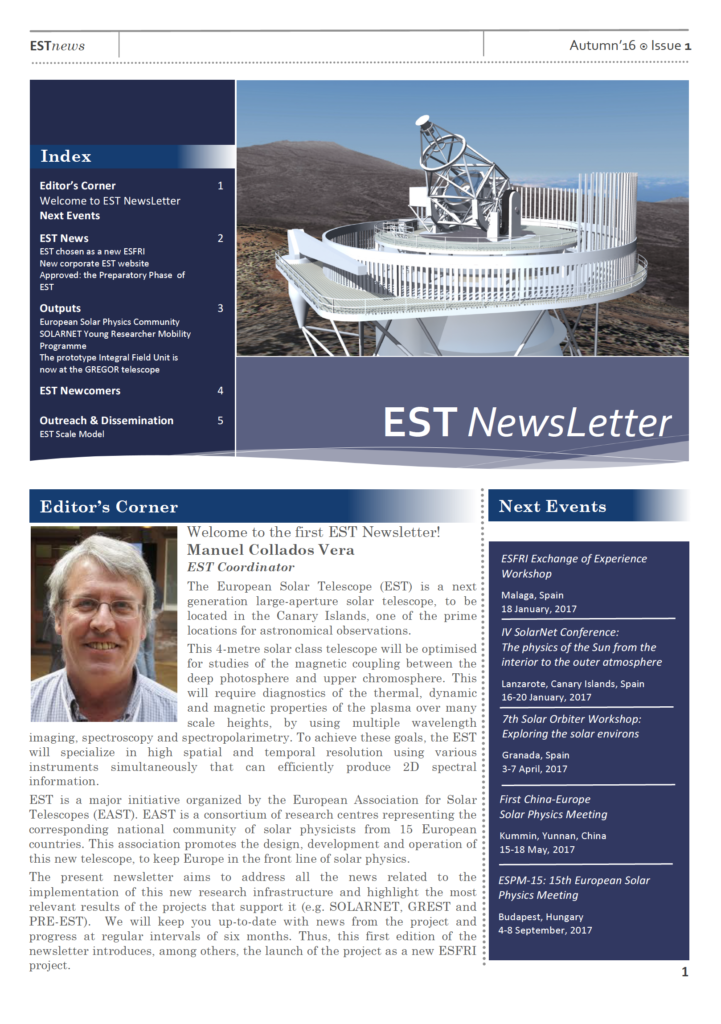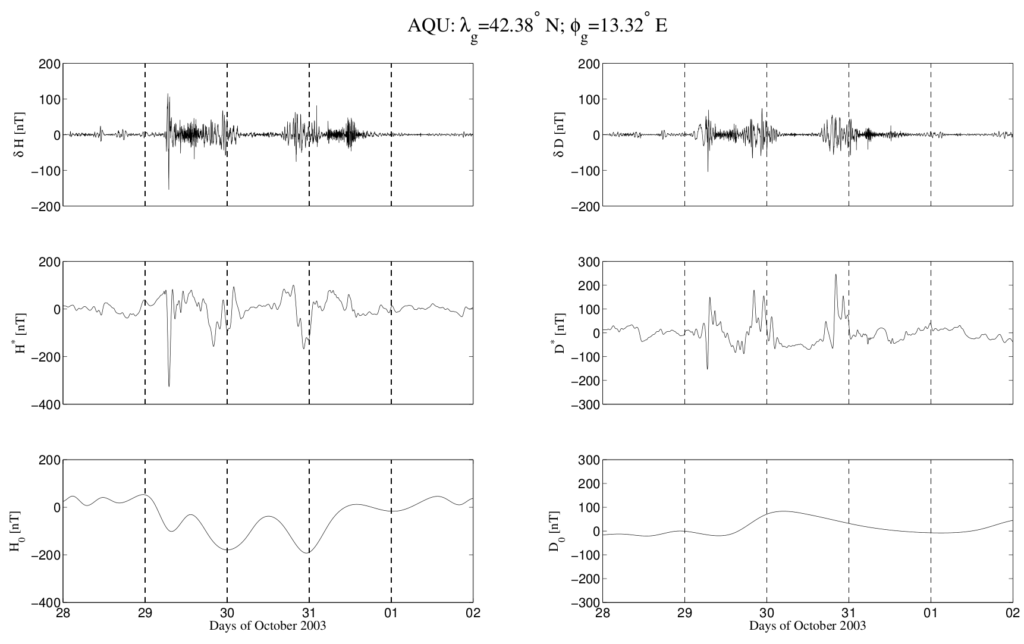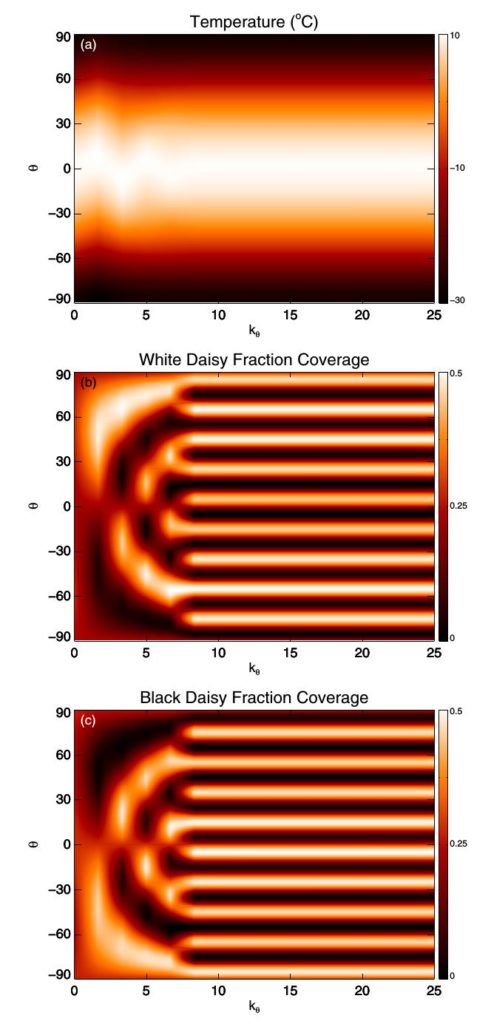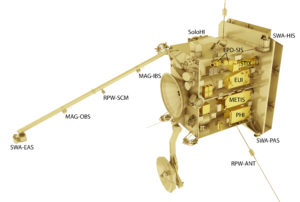Home » SWICo News (Page 4)
Category Archives: SWICo News
EST Newsletter Autumn 2016
 We are pleased to inform you that the first issue of ESTnews is out!
We are pleased to inform you that the first issue of ESTnews is out!
The purpose of this publication is to keep you informed about the progress of the European Solar Telescope (EST) project.
Please download a digital version in the following link: Download the PDF version
In this first issue:
- EST chosen as a new ESFRI
- New corporate EST website
- Approved: the Preparatory Phase of EST
- European Solar Physics Community
- SOLARNET Young Researcher Mobility Programme
- The prototype Integral Field Unit is now at the GREGOR telescope
- EST Newcomers
- EST Scale Model
More information at www.est-east.eu
Identification of the different magnetic field contributions during a geomagnetic storm

We announce to the community a recently published paper on the identification of the different magnetic field contributions during a geomagnetic storm in magnetospheric and ground observations. The authors of the paper are SWICo members from different institutions.
Abstract:
We investigate the time variation of the magnetospheric and Earth’s magnetic field during both quiet and disturbed periods. We identify the timescale variations associated with different magnetospheric current systems, solar-wind–magnetosphere high-frequency interactions, ionospheric processes, and internal dynamics of the magnetosphere. In addition, we propose a new local index for the identification of the intensity of a geomagnetic storm on the ground.
Spatial interactions in a modified Daisyworld model
We point out to the community an interesting paper by the UNICAL group on a modified version of the Daisyworld model. First author of the paper is the SWICo member Tommaso Alberti.
 Abstract:
Abstract:
We investigate a modified version of the Daisyworld model, originally introduced by Lovelock and Watson to describe in a simple way the interactions between an Earth-like planet, its biosphere, and the incoming solar radiation, where spatial dependency, variable heat diffusivity, and greenhouse effect are explicitly taken into account.
In this way, we obtain a more realistic energy-balance model to investigate the evolution of the Earth’s climate by considering several influencing factors.
The model is based on a hypothetical planet, like the Earth, which receives the radiant energy coming from a Sun-like star, and is populated by two kinds of identical plants differing in their color: white daisies reflecting light and black daisies absorbing light. The interactions and feedbacks between the collective biota of the planet and the incoming
radiation form a self-regulating system where the conditions for life are maintained.
We show that the diffusion process is able to destabilize the system and plays an important role in setting the symmetry with respect to the equator. The greenhouse effect, modeled through a grayness function, affects the temperature evolution and contributes to self-regulating the planet climate, in agreement with observational data analysis.
The equilibrium state is significantly dependent on the initial conditions. The initial conditions of daisy
coverage influence the vegetation profiles although they do not significantly modify the temperature behavior. This implies that a different surface coverage by oceans, ice and vegetation can locally change their interactions, producing local micro-climate (similar to the climatic zones).
This model could be very useful in the framework of climate changes, due to its simplicity, to provide both global and local informations about temperature and biosphere changes.
Registration is open for the 7th Solar Orbiter workshop
 We are happy to re-post here the announcement of the 7th Solar Orbiter workshop:
We are happy to re-post here the announcement of the 7th Solar Orbiter workshop:
Planetary space weather: scientific aspects and future perspectives
We announce to the community a recently published review-paper on planetary space weather. First author of the paper is the SWICo member Christina Plainaki.
Abstract:
In this paper, we review the scientific aspects of planetary space weather at different regions of our Solar System, performing a comparative planetology analysis that includes a direct reference to the circum-terrestrial case. Through an interdisciplinary analysis of existing results based both on observational data and theoretical models, we review the nature of the interactions between the environment of a Solar System body other than the Earth and the impinging plasma/radiation, and we offer some considerations related to the planning of future space observations. We highlight the importance of such comparative studies for data interpretations in the context of future space missions (e.g. ESA JUICE; ESA/JAXA BEPI COLOMBO). Moreover, we discuss how the study of planetary space weather can provide feedback for better understanding the traditional circum-terrestrial space weather. Finally, a strategy for future global investigations related to this thematic is proposed.
H2020 SWe 2016
Vi segnaliamo i bandi H2020 in apertura il prossimo 8 novembre
Poniamo la vostra attenzione in particolare alle call:
COMPET-4-2017: Scientific data exploitation
COMPET-5-2017: Space Weather
La call “Scientific data exploitation” è stata esplicitamente estesa all’eliofisica ed all’esplorazione del sistema solare, mentre nel 2015 era limitata al sole e alle scienze planetarie.
